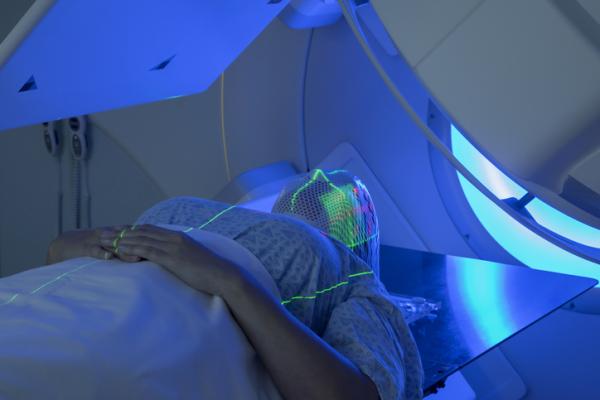
October 2, 2023 — A type of head and neck cancer predominantly diagnosed in people who reside in low- and middle-income countries may be treated effectively with fewer, but higher doses of radiation, a large new international study suggests.
The study – a randomized phase III clinical trial involving 10 countries across four continents – found delivering a course of radiation in 20 rather than 33 treatment sessions was just as effective at controlling cancer for patients with alcohol and tobacco-related, locally advanced disease, without increasing side effects. Findings from the HYPNO (HYPo- versus NOrmo-fractionated accelerated radiotherapy) trial will be presented today at the American Society for Radiation Oncology (ASTRO) Annual Meeting.
“Head and neck cancer caused by factors other than the human papillomavirus (HPV) remains a significant burden especially in lower- and middle-income countries,” said lead study author Søren Bentzen, PhD, DMSc, a professor of radiation oncology and Director of the Division of Biostatistics and Bioinformatics, Department of Epidemiology and Public Health, at the University of Maryland School of Medicine in Baltimore. “This is a trial that directly informs how you can effectively deliver radiation therapy to patients in a resource-scarce environment.”
Squamous cell head and neck cancers are the seventh most common type of cancer in the world, accounting for 450,000 deaths each year. Head and neck cancers have historically been associated with tobacco and alcohol use, including secondhand smoke and chewing tobacco. While head and neck cancers associated with the human papillomavirus (HPV) typically occur in younger, otherwise healthy people, cancers related to tobacco and alcohol generally affect older people who have comorbidities that can complicate treatment.
Unlike in the U.S. and many other high-income countries, the incidence of these cancers is rising in low- and middle-income countries, where rates already are disproportionately high. For example, head and neck cancers account for 30% of all cancer diagnoses in India, compared to 4-5% globally, and an estimated 84% of deaths from head and neck cancer occur in low- and middle-income countries.
Standard treatment for patients with locally advanced squamous cell head and neck cancers in these countries typically involves up to seven weeks of radiation therapy. Low- and middle-income countries often face a substantial undersupply of radiation therapy facilities, however, forcing many patients to travel great distances and remain away from home for long periods of time to receive care.
In this study, sponsored by the International Atomic Energy Agency in Vienna, Dr. Bentzen and his colleagues investigated whether a shorter course of radiation could be equally effective as standard treatment, without increasing the risk for side effects that could harm quality of life. Dr. Bentzen said the hypothesis grew out of years of mathematical modeling suggesting a shorter, more intense radiation course could deliver outcomes similar to current treatment regimens.
To test this model’s accuracy, he and his colleagues enrolled 792 patients from 12 health centers in 10 low- and middle-income countries: Uruguay, Brazil, Argentina, Cuba, South Africa, India, Pakistan, Thailand, Indonesia and the Philippines.
All participants in the trial had locally advanced head and neck cancer; a variety of tumor sites were represented, most commonly the oropharynx (50.5%). Patients were predominantly (87%) male, and most (87%) had a history tobacco smoking or chewing. The majority (73%) were diagnosed with stage three or four cancer, with nearly half (49%) having cancer that had spread to the lymph nodes.
Patients were treated with radiation therapy in either 33 fractions (66 Gy, six fractions per week for 5.5 weeks) or 20 fractions (55 Gy, five fractions per week for 4 weeks). Most patients (76%) also received chemotherapy.
After three years, patients who received the accelerated treatment had roughly the same level of locoregional tumor control (test for non-inferiority within a 10% margin, p=0.041) and late-term side effects (test for non-inferiority within a 10% margin, p=0.004) as those who received the longer treatment. The overall survival and progression-free survival rates three years after treatment also were not significantly different between the groups (OS: p=0.62, 54.1% hypofractionated vs. 55.5% conventional; PFS: p=0.42, 44.0% vs. 45.3%).
“Accelerating radiation treatment is tricky because delivering too high a dose or too many doses too quickly can cause side effects that lower a person’s quality of life,” said Dr. Bentzen. “But not delivering enough radiation may allow the cancer to return.”
“There is actually a sweet spot where you get exactly the right balance between the total dose, the total treatment time and the dose you deliver in each fraction,” he said. “The net result is that you hit the tumor hard enough to get good control, but you don’t affect the normal tissue more than you would with the standard treatment.”
Dr. Bentzen said he and his team are completing additional subgroup analyses to confirm the accelerated regimen is effective for a wide variety of patient types, and initial findings suggest that it will be.
For more information: www.astro.org


 April 25, 2024
April 25, 2024 








